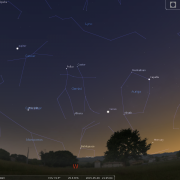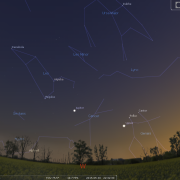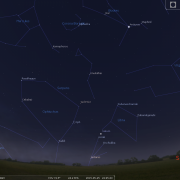In this month's Sky Notes:
Planetary Skylights
Looking West: Jupiter, Venus
and Mercury on 06-May at
21:45h (twilight)
(Click image for full-size view)
 Venus, the brilliant evening star, dominates the evening western twilight sky, moving up through the winter constellation of Taurus as the bull slips down toward the western horizon. Over the course of the month Venus passes between the two open star clusters in Taurus, the Pleiades or seven sisters on the 11th and the Hyades from the 13-16th. Aldeberan, the fiery eye of the bull, will lie to the left of Venus. Telescopically Venus is best observed in bright twilight, reducing the glare of the planet somewhat. You should then be able to detect the gibbous phase of the planet. The young crescent moon is nearby on the 21st.
Venus, the brilliant evening star, dominates the evening western twilight sky, moving up through the winter constellation of Taurus as the bull slips down toward the western horizon. Over the course of the month Venus passes between the two open star clusters in Taurus, the Pleiades or seven sisters on the 11th and the Hyades from the 13-16th. Aldeberan, the fiery eye of the bull, will lie to the left of Venus. Telescopically Venus is best observed in bright twilight, reducing the glare of the planet somewhat. You should then be able to detect the gibbous phase of the planet. The young crescent moon is nearby on the 21st.
 For the first three weeks of May Mercury continues its spring evening apparition low in the WNW sky. Look for it 45 minutes after sunset a ‘fist’ height above the horizon, lower right of Venus. Use binoculars if you cannot initially spot it with just the naked eye. The moon passes in the vicinity on the 19th, although Mercury will be more difficult to spot by then.
For the first three weeks of May Mercury continues its spring evening apparition low in the WNW sky. Look for it 45 minutes after sunset a ‘fist’ height above the horizon, lower right of Venus. Use binoculars if you cannot initially spot it with just the naked eye. The moon passes in the vicinity on the 19th, although Mercury will be more difficult to spot by then.
 Jupiter is well placed quite high in the SW aspect of the sky, but is gradually slipping down westwards towards the horizon. As it does so, Venus draws ever closer. The pair will have a spectacular conjunction later in June. The moon lies nearby on the 24th.
Jupiter is well placed quite high in the SW aspect of the sky, but is gradually slipping down westwards towards the horizon. As it does so, Venus draws ever closer. The pair will have a spectacular conjunction later in June. The moon lies nearby on the 24th.
 Finally, and certainly not least, Saturn comes to opposition on May 23rd, residing due south at midnight. Before then you will be able to view the ‘ringed wonder’ from 10pm across in the east, a steady bright ‘pearly star’ residing above the ruddy hue of Antares, chief star in Scorpius. Through a scope the ring system appears wide open and is a magnificent sight. Look for Titan, Saturn’s largest moon as a speck of light nearby. Our moon lies nearby on the 6th.
Finally, and certainly not least, Saturn comes to opposition on May 23rd, residing due south at midnight. Before then you will be able to view the ‘ringed wonder’ from 10pm across in the east, a steady bright ‘pearly star’ residing above the ruddy hue of Antares, chief star in Scorpius. Through a scope the ring system appears wide open and is a magnificent sight. Look for Titan, Saturn’s largest moon as a speck of light nearby. Our moon lies nearby on the 6th.
Meteor Activity

The Eta Aquarid meteor shower peaks in the early morning hours on the 6th, as Aquarius is rising. This is one of two meteor showers associated with debris particles deposited over time by comet Halley, the other shower being the Orionids, which peak in late October.
Although the Eta Aquarids have a ZHR (zenith hourly rate) approaching 30, Aquarius is only just rising in the SE shortly before dawn and actual observed rates will be less than half of this at best. A waning gibbous moon will also restrict numbers.
February 2015 Sky Charts
Click each image to see a full-size Sky Chart:
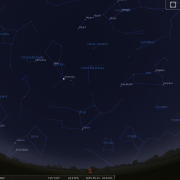 |
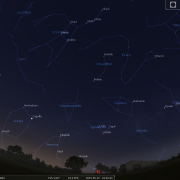 |
| Looking South Mid May - 22:30h |
Looking North |
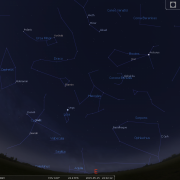 |
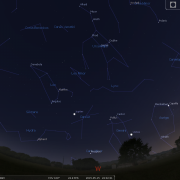 |
| Looking East Mid May - 22:30h |
Looking West Mid May - 22:30h |
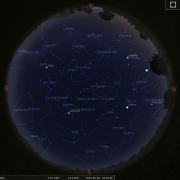 |
|
| Overview Mid May - 21:15h |
Image Credits:
- Planets and Comets where not otherwise mentioned: NASA
- Sky Charts: Stellarium Software
- Log in to post comments

